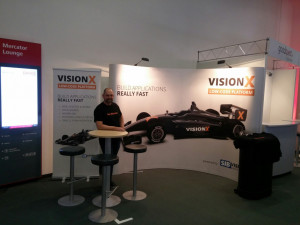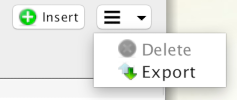VisionX 5.3 is available
VisionX 5.3.2 is available!
It's a minor update release with big changes.
The release got updates of open source libraries like JVx and Vaadin UI.
But the biggest changes are the integrated Java 12 support. VisionX 5.3 comes with and runs under Java 12 (openJDK).
What's different?
- Performance improvement of Designer
- Performance improvement of HTML5 UI
- New App Elements
Save All Changes, Reload All Changes, Advanced Panel and Advanced Group Panel
- REST documentation contains admin services
- Bundled open JDK 12
- Support for latest Workflow AddOn (1.5)
The download area already contains links to latest VisionX binaries.
Please report any problems as usual and have fun with VisionX.
Eclipse 2018.12 with ANT and JRE 6
The support for ANT and JRE6 with Eclipse 2018.12.
The plugin was created for:
Build id: 20181214-0600
Don't forget the -clean start (read the original article for more details)!
One more thing you should do:
Photon includes ANT > 1.10. This version requires Java 8. In order to use Java 6, you have to download ANT 1.9.x. Simply download ANT and set the ANT Home to your version, via
If you try to use the bundled ANT with JRE 6, it will fail with an Exception.
Download the plugin from here. It works for us - no warranty!
More Details: Eclipse Photon with ANT and JRE6.
VisionX 5 update Release-3
VisionX 5.2.27 is available!
It's a small bugfix release with an update of open source libraries like JVx and Vaadin UI.
What's different?
- Group Panel visibility now working in Browser
- Group Panel text color now working in Browser
- Set additional css class names for labels and checkbox editors
- It's now easier to extend search behavior of NavigationTable
- Checkbox alignment fixed in Browser
- Support for latest Workflow AddOn
The download area already contains links to latest VisionX binaries.
Please report any problems as usual and have fun with VisionX.
We're hiring
Wir suchen Verstärkung für unser Framework Team. Wenn du immer schon an einem Open Source Framework mitarbeiten wolltest und Forschung/Entwicklung genau das ist was dir zusagt, dann bewirb dich bitte!
VisionX 5 update Release-2
We're happy to anounce that VisionX 5.1.221 is available!
It's a bigger update release of VisionX 5.1.8 with with some new "visible" features and many awesome new features under the hood.
Let's start with important bug fixes
- Popup Menu in Browser application
A custom Popup Menu in Browser applications was always empty. This problem was fixed in an OpenSource library and is now available in VisionX applications.
- Timeout with customizer changes
If VisionX timeout while a customizer with changed values was open, the timeout operation failed and VisionX was unusable.
- Element selection not always working
Sometimes it wasn't possible to select elements if they where behind other elements.
- Database procedure and function calls with more than 10 parameters
It's now supported to call database procedures and functions with max. 100 parameters.
- External CSS file detection
VisionX had some path problems with Linux and MacOS to find the external CSS file for browser applications.
- Fixed painting of overlays (MacOS)
The position of e.g. VisionX Guides wasn't correct. The small numbers were wrong positioned.
- Workflow integration
The workflow engine wasn't always started correctly and not in the correct window.
- All bugfixes of JVx, VaadinUI and other OpenSource libraries
What's new?
- A new Workflow AddOn
- Swagger documentation
The documentation now contains information about sub storages (used in drop down boxes) and default admin services. It's now easier to grant access to external applications based on the REST API of your application.
- Java 9+
It's now possible to use e.g. Java 11 as runtime for VisionX.
- Storage editor for Developers
Out storage Editor was only available if you bought the Forms license. Now all users with Development license will be able to use the Storage Editor. The storage editor is a feature which allows you to change the database query of a table, directly in VisionX.
- Prompt/Placeholder support
- Better layouting in browser application
We improved the layouting in our browser applications and also improved scrolling of panels.
- Experimental (Early Access) Features
We added some experimental features in this release: QR code authentication, Spnego (Active Directory) authentication base support (needs an additional AddOn), SSO authentication feature for REST services (bypass option).
This features are available for interested developers. Simply talk to your contact person.
The download area already contains links to latest VisionX binaries.
Please report any problems as usual and have fun with VisionX.
JVx 2.8 is available
We're happy to announce that JVx 2.8 is available. It's a big release with lots of important bug fixes and some awesome new features. The last release of JVx was in January. It was version 2.7 which was more or less a small bugfix release with few new features. We took more time for JVx 2.8 to make it awesome.
What's new?
- Placeholder/Prompt support
This feature is available for input fields and cell editors. Simply enable this feature:
editor.setPlaceholderVisible(true);
editor.setPlaceholder("PLACEHOLDER");to get
- New popup menu button
This new button reduces the visible components. It's a must have for modern applications:
- Savepoints for transaction handling in PostgreSql
- Components have a unique name
This is an important feature fore UI tests and our headless UI as well. It's now possible to address components in vaadin UI by their id to apply custom css.
- Configurable REST services
- Mac OS UI improvements
The full changelog is available here.
DOAG 2018 - Low code
| Let's talk about VisionX and Low Code Development at DOAG 2018 |
 |
| We're waiting for your questions |
 |
New VisionX Demo application is available
Our VisionX solution store got a new demo application. It's a demo for calculated columns. A calculated column is a virtual column, filled with custom content.
Simply install the application from our solution store:
The application has 3 workscreens. One demonstrates client-side calculated columns, the second one server-side calculated columns and the third screen demonstrates calculated columns directly in the database. You have different options to use calculated columns, simply check what you prefer.
DOAG 2018 - I'm a speaker
 |
I'm a speaker at DOAG 2018 in Nuremberg. It's the 5th year in a row My German talk will be about The talk is a practice report about using a Low Code Development Platform to create a Workflow for Web and (Web/native) Mobile apps. |





 RSS-Feed
RSS-Feed